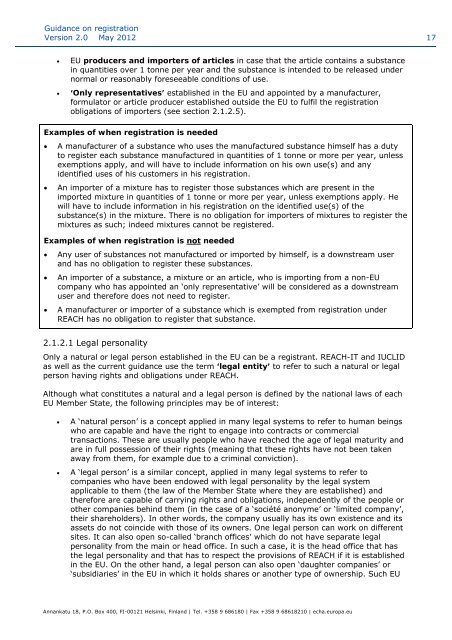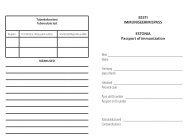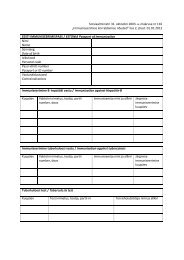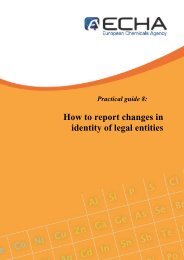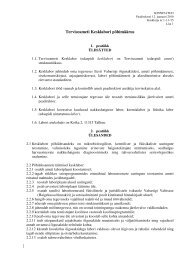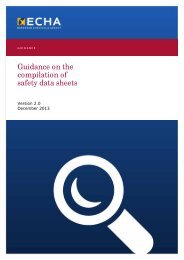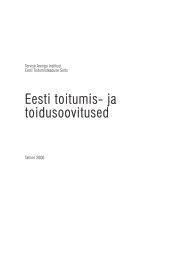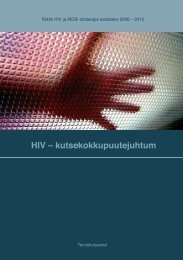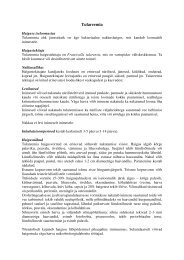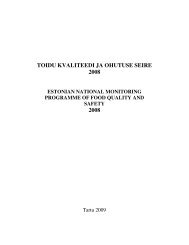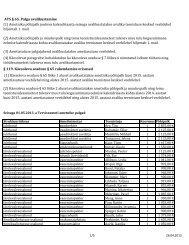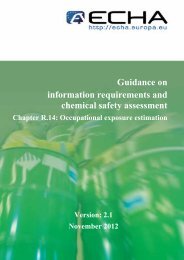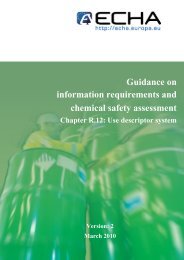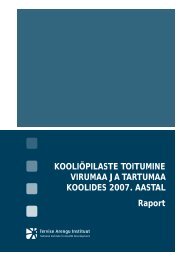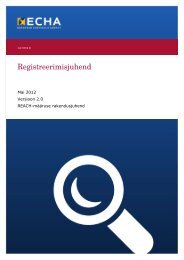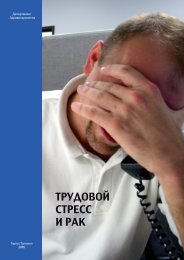Guidance on registration - ECHA - Europa
Guidance on registration - ECHA - Europa
Guidance on registration - ECHA - Europa
You also want an ePaper? Increase the reach of your titles
YUMPU automatically turns print PDFs into web optimized ePapers that Google loves.
<str<strong>on</strong>g>Guidance</str<strong>on</strong>g> <strong>on</strong> registrati<strong>on</strong><br />
Versi<strong>on</strong> 2.0 May 2012 17<br />
<br />
<br />
EU producers and importers of articles in case that the article c<strong>on</strong>tains a substance<br />
in quantities over 1 t<strong>on</strong>ne per year and the substance is intended to be released under<br />
normal or reas<strong>on</strong>ably foreseeable c<strong>on</strong>diti<strong>on</strong>s of use.<br />
‘Only representatives’ established in the EU and appointed by a manufacturer,<br />
formulator or article producer established outside the EU to fulfil the registrati<strong>on</strong><br />
obligati<strong>on</strong>s of importers (see secti<strong>on</strong> 2.1.2.5).<br />
Examples of when registrati<strong>on</strong> is needed<br />
A manufacturer of a substance who uses the manufactured substance himself has a duty<br />
to register each substance manufactured in quantities of 1 t<strong>on</strong>ne or more per year, unless<br />
exempti<strong>on</strong>s apply, and will have to include informati<strong>on</strong> <strong>on</strong> his own use(s) and any<br />
identified uses of his customers in his registrati<strong>on</strong>.<br />
<br />
An importer of a mixture has to register those substances which are present in the<br />
imported mixture in quantities of 1 t<strong>on</strong>ne or more per year, unless exempti<strong>on</strong>s apply. He<br />
will have to include informati<strong>on</strong> in his registrati<strong>on</strong> <strong>on</strong> the identified use(s) of the<br />
substance(s) in the mixture. There is no obligati<strong>on</strong> for importers of mixtures to register the<br />
mixtures as such; indeed mixtures cannot be registered.<br />
Examples of when registrati<strong>on</strong> is not needed<br />
<br />
<br />
<br />
Any user of substances not manufactured or imported by himself, is a downstream user<br />
and has no obligati<strong>on</strong> to register these substances.<br />
An importer of a substance, a mixture or an article, who is importing from a n<strong>on</strong>-EU<br />
company who has appointed an ‘<strong>on</strong>ly representative’ will be c<strong>on</strong>sidered as a downstream<br />
user and therefore does not need to register.<br />
A manufacturer or importer of a substance which is exempted from registrati<strong>on</strong> under<br />
REACH has no obligati<strong>on</strong> to register that substance.<br />
2.1.2.1 Legal pers<strong>on</strong>ality<br />
Only a natural or legal pers<strong>on</strong> established in the EU can be a registrant. REACH-IT and IUCLID<br />
as well as the current guidance use the term ‘legal entity’ to refer to such a natural or legal<br />
pers<strong>on</strong> having rights and obligati<strong>on</strong>s under REACH.<br />
Although what c<strong>on</strong>stitutes a natural and a legal pers<strong>on</strong> is defined by the nati<strong>on</strong>al laws of each<br />
EU Member State, the following principles may be of interest:<br />
<br />
<br />
A ‘natural pers<strong>on</strong>’ is a c<strong>on</strong>cept applied in many legal systems to refer to human beings<br />
who are capable and have the right to engage into c<strong>on</strong>tracts or commercial<br />
transacti<strong>on</strong>s. These are usually people who have reached the age of legal maturity and<br />
are in full possessi<strong>on</strong> of their rights (meaning that these rights have not been taken<br />
away from them, for example due to a criminal c<strong>on</strong>victi<strong>on</strong>).<br />
A ‘legal pers<strong>on</strong>’ is a similar c<strong>on</strong>cept, applied in many legal systems to refer to<br />
companies who have been endowed with legal pers<strong>on</strong>ality by the legal system<br />
applicable to them (the law of the Member State where they are established) and<br />
therefore are capable of carrying rights and obligati<strong>on</strong>s, independently of the people or<br />
other companies behind them (in the case of a ‘société an<strong>on</strong>yme’ or ‘limited company’,<br />
their shareholders). In other words, the company usually has its own existence and its<br />
assets do not coincide with those of its owners. One legal pers<strong>on</strong> can work <strong>on</strong> different<br />
sites. It can also open so-called ‘branch offices’ which do not have separate legal<br />
pers<strong>on</strong>ality from the main or head office. In such a case, it is the head office that has<br />
the legal pers<strong>on</strong>ality and that has to respect the provisi<strong>on</strong>s of REACH if it is established<br />
in the EU. On the other hand, a legal pers<strong>on</strong> can also open ‘daughter companies’ or<br />
‘subsidiaries’ in the EU in which it holds shares or another type of ownership. Such EU<br />
Annankatu 18, P.O. Box 400, FI-00121 Helsinki, Finland | Tel. +358 9 686180 | Fax +358 9 68618210 | echa.europa.eu


